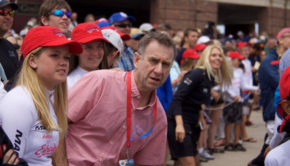The State of the Sport in 2020
Published on April 16th, 2020
by Craig Leweck, Scuttlebutt Sailing News
Since 1997, Scuttlebutt has been providing sailing enthusiasts with their daily download of news, and when you report on the sport for that long, spending each day looking at the activity, you see a lot more than race results.
I have three observations when considering the State of the Sport:
• When the cost in time and money to participate exceeds the pleasurable benefit, people seek alternative activities.
• Better isn’t always best, as the natural inclination for improvement slowly eliminates those that choose not to chase the rising bar.
• We are capable of evolving toward extinction.
While our sport is immensely varied, in both the boats we sail and the areas we sail them, and as the USA is equally varied, not everyone’s pros and cons are the same. However, there are several issues that have reach:
On the subject of communication, maybe Scuttlebutt is to blame on this one, but when we began people dialed the phone to speak to each other. You motivated participation by direct contact, but now we rely on exceedingly passive tools. While modern options are great, they are but one leg of the table. You need to leverage all tools, not just some of them. We can’t forget that a sport which thrives through a strong social network needs people to speak to each other.
We are living in the most dynamic period of boat design development, but progress keeps increasing performance, which invariably increases cost, and increased performance requires greater skill. Sportboats began small but now go around the world, and the new chapter is foiling. This is all great but it does impact who can participate. Increasing cost and skill is not a growth formula, and the more we define sailing in these modern terms, the sooner we are at writing its obituary.
When we look at sails, cordage, electronics, hardware, everything has contributed to an increase in performance, but an increase in cost too. At some point people walk away for an alternative recreation, and for those that pull out the credit card to buy the better sailing stuff, they are all even again, having about the same amount of fun, but for more money.
While the elite end of the sport is eager for improvement, this grand-prix style gear is used on beercan-level programs. Worse, when you are spending $1,000+/- on a compass that also helps you get a perfect start, skill is getting replaced with credit cards which is not a growth formula.
The good news is you can still affordably get into this sport. There are loads of fiberglass keelboats that provide sturdy platforms for racing, but if you chase these fancy upgrades, the equipment cost can exceed the boat cost. If that didn’t deter people, it remains critical to have a calendar of events that is better geared for the racer-cruiser crowd.
There aren’t too many areas in life where we’re not trying harder, and for sailing, the lessons learned in other sports are applicable. More training, more coaching, and while that’s great at the elite level, and to some extent at the youth level, it is not so great when it bleeds into the recreational level. Not everyone can make the commitment, and increased effort impacts opportunity for outliers, which isn’t a growth formula.
It was in 1986, over 30 years ago, when Sailing World magazine unleashed a hurricane of an interview with Dave Ullman titled, ‘Get the Pros Out of Racing‘. Dave saw the future, and while people at the time thought he just wanted to play golf on the weekends, we are now in a land where an HR department is needed at the top end of competition.
We view sailing as unlike other sports as it allows us to compete against the Tiger Woods, but Dave would witness how people like to say that, and they like seeing Tiger Woods on the start line, but over time getting crushed by Tiger Woods gets old.
Fast forward to now and the pro sailors are massively better than they used to be, and they are using recreational sailing as their business. Plus, it used to be where the pro sailors worked for companies and gave back to the sport as they sought to sell sails or gear, but now the pro sailors are independent contractors whose job is to win for their client. Giving back is not necessarily a priority.
What’s occurred at the youth stage is a case study of unintended consequences. When kid programming in the 1980s created institutional-type boats that required less skill, and with clubs buying the boats, participation soared. It continues to this day, but at what cost?
The kids are being steered away from all the other options in the sport, which has impacted participation in those areas. Also, not all kids liked this limited youth menu so some tapped out, and those that stayed with it were learning less in these non-technical boats, which hasn’t helped the US Olympic program.
Finally, because the kids missed all the random touch points that occurred in previous generations, along with the adult mentoring that occurs, they are a bit lost in the wind when they age-out from the youth provided programming.
Attrition follows, and the response has been to lengthen the road, which has led to club-owned keelboats and more provided boat events like team racing or club challenge events. Integrating kids early, to some degree, into the adult-type options that exist in their area is key to their ability to continue in the sport.
There was a thread in Scuttlebutt not long ago which addressed the rising standards in race management and the challenging conditions to reach them, but I blame the sailors for wanting professionalism out of volunteers.
As a result, we now have professional, paid race officers, which I suspect is a trend that will continue, thus impacting costs and likely not helping advance the volunteer army.
Volunteerism shouldn’t be a hassle, it should be another way to enjoy this sport. We need to celebrate the volunteers and to the degree necessary, clubs need to provide the tools and education to maintain this segment.
At some point in time our pursuit of perfection took over our weekend regattas, and every course configuration became windward-leewards, and every event took on the format of a world championship.
So for decades now we have been promoting a plan that emphasizes excellent crew work, refined tactics, elite speed, and in handicap racing, benefits modern boats that have efficient layouts. Plus now, the trend has been to get as many races in a day as possible.
We have effectively squeezed out the casual competitors, and worse, socializing may be getting sacrificed too.
None of this is a growth formula, but conversely we see great participation when events set the tone through shorter days, random courses, and strong after parties. There is a reason why mid-week racing is so popular.
While certain events should hold high standards and perfect course types, the lunchbox crowd can’t be forgotten. However, changing the NOR isn’t enough if seeking to bring people back to the sport. You’ve got to pull out your landline, dial numbers, and convince people it is safe to come out and play again.
The absence of a unified rating rule system in the USA has had a compounding affect. The regionalism of rules has reduced the prominence of events, which impacts interest. Big boat people now dream smaller, or have traded their big boats in for smaller one designs, thus shrinking crew opportunity, which is a gateway into the sport. The leading yacht clubs in the country need to agree and support a strong unified system.
However, the good news is how the basics still apply:
No matter how busy we are, we still take time for what gives us pleasure.
When we make things fun, and care for how we play our game, people want to participate. A strong culture that views the sum as massively more important than the parts, keeps the parts coming back. While we can create a lot of rules to address the nagging variables that impact participation, a strong culture of right and wrong always is the best solution.
Success follows the sparkplug. Recently, one person at San Diego Yacht Club built a Finn fleet from non-existent to the largest in the USA. It takes epic passion on the part of that person, and likely the ability to talk on a phone, but this approach has always built activity.
Family involvement leads to continuity. Thistles and Lightnings have been passed down through generations, and lord knows how much inbreeding occurs in Scow country (just kidding). I hold that area, the Inland Lake Yachting Association, in the highest regard and with the greatest respect. They do it right.
Ultimately, everyone needs a thing in their life beyond work, and when sailing is that thing, and when it goes beyond competition and becomes part of a person’s social life, the attraction increases and retention decreases. Sailing can check so many boxes, and when considering the future of the sport, that’s the formula to strive for, to give people something that is necessary for their happiness.









 We’ll keep your information safe.
We’ll keep your information safe.